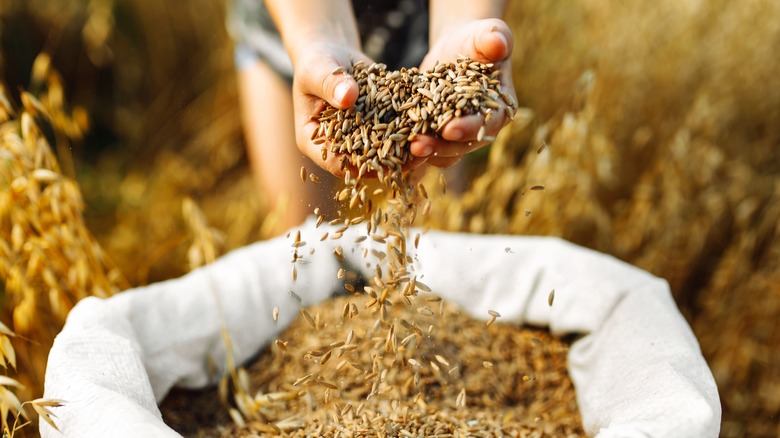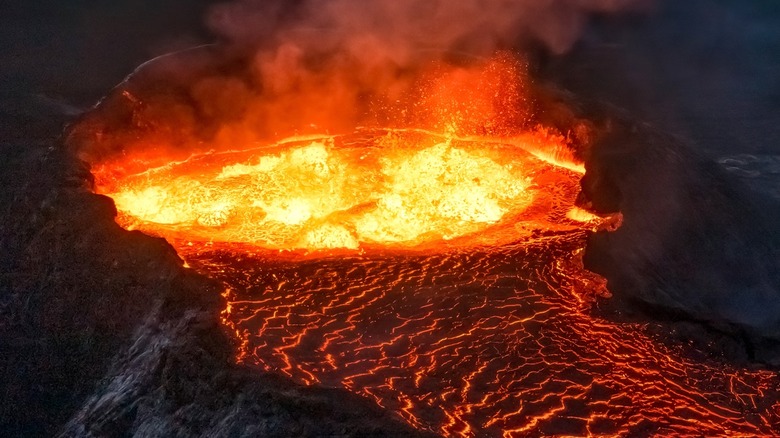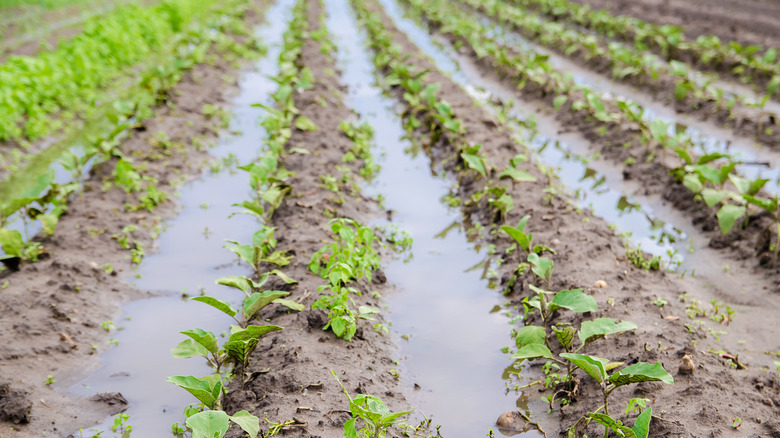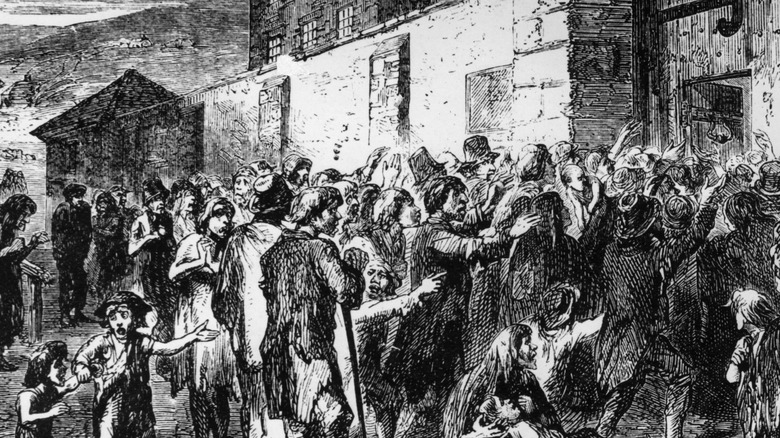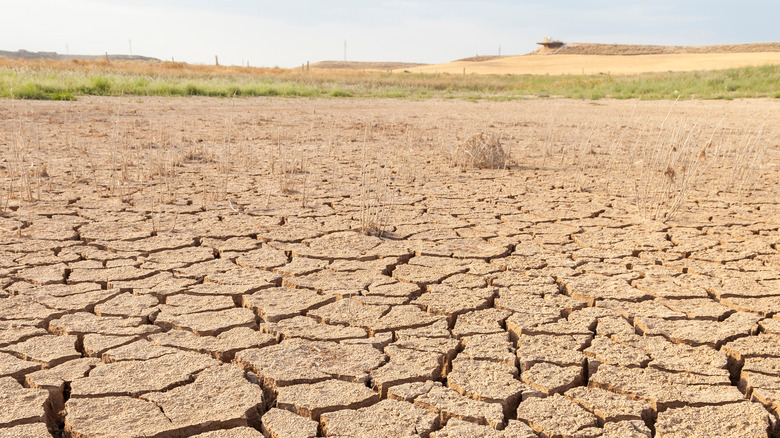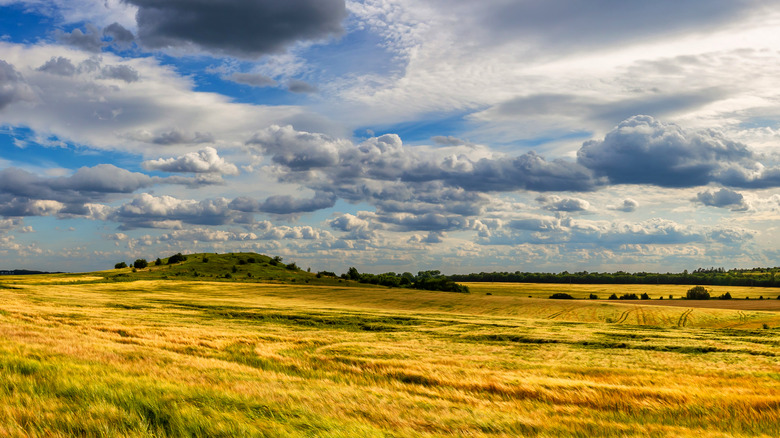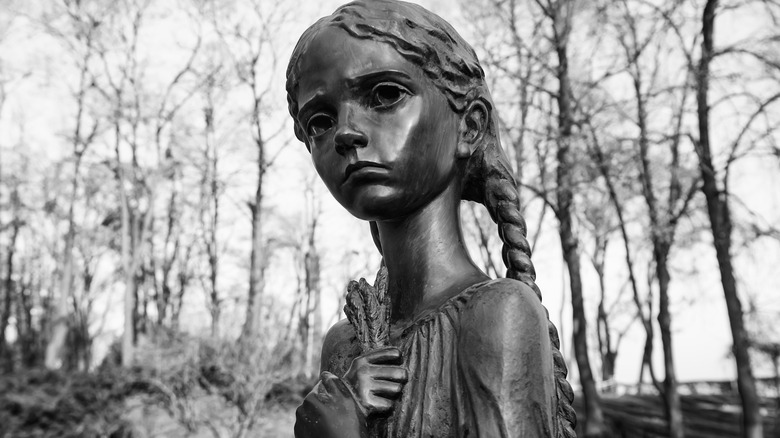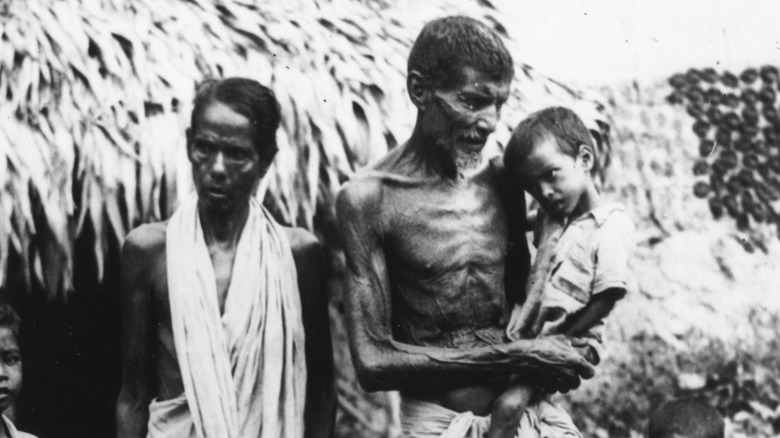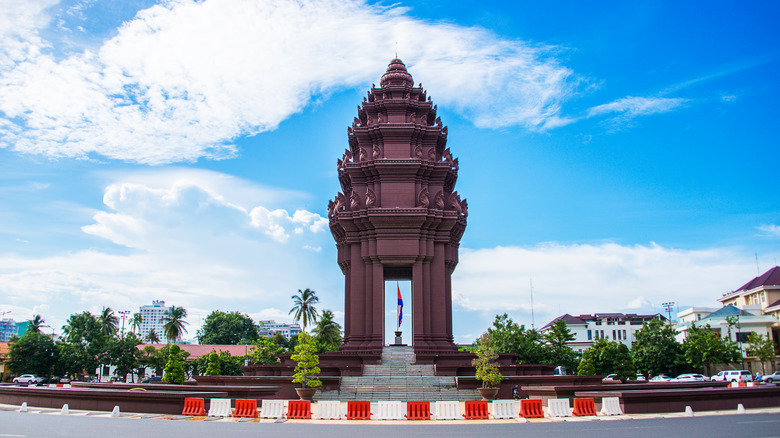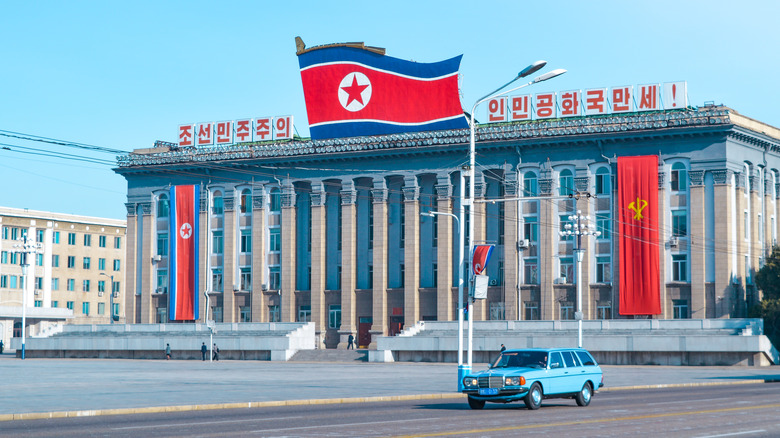10 Of The Worst Food Shortages Throughout History
The following article includes mentions of starvation, suffering, and death on a large scale.
In recent years, supply chain issues have been rising in frequency. While we used to be able to walk into the grocery store and always buy our favorite foods, that has become increasingly difficult. The same goes for our favorite fast food restaurants: Sometimes, they simply run out of food. As annoying as this tends to be, this problem is hardly new to humanity. In fact, throughout history, there have been extreme food shortages that make modern supply chain struggles seem small by comparison. These famines, as most of them are remembered, didn't just end in frustration at the supermarket, but in death on a massive scale.
According to the International Rescue Committee, modern famines are officially declared when at least 30% of children in a specific area are severely malnourished. Unfortunately, this means that the population has already begun to grow sick and die from mass food shortages by the time the event is labeled. Famines can be caused by natural hazards, but they also are made worse by human interference (or lack thereof) in the supply problem. These are some of the worst food shortages throughout history, listed in chronological order.
536: The Volcanic Winter
The year 536 is known to be one of the most horrific years in human history. According to Science, it was a year filled with famines, plagues, and a volcanic eruption that caused a nearly endless winter.
It started when blankets of fog covered much of Europe, northern Asia, and the Middle East. The fog was so thick that it blocked out the sun for over a year and a half. As the Byzantine historian Procopius wrote: "For the sun gave forth its light without brightness, like the moon, during the whole year." This caused crops to fail across the impacted areas, with the resulting food shortage starving millions.
For generations, the reason behind this fog was a mystery. Research from Harvard, however, suggests that there was a massive volcanic eruption in Iceland at the beginning of the year. As the ash billowed across the continent of Europe, substances like sulfur and bismuth restricted Earth's access to life-giving sunlight. Instead, much of the sun's light and heat was sent back into space, making the planet significantly colder and worsening food scarcity for many years.
1315 to 1317: The Great Famine
The United Kingdom is known for grey skies and rainy weather. However, in the early 14th century, the abnormally rainy summer of 1314 caused a famine, per Historic UK. As the rain continued to fall, the ground eventually became too waterlogged. As the water had nowhere to go, it began to build and build without draining. For the next couple of years, a significant amount of rain continued to fall. The ground became too bloated for farming; if a farmer was somehow able to get crops in the ground, they would just take on water and spoil. Some livestock drowned in the floods, while others starved to death because there wasn't any food for them.
What little food reserves the population had on hand dwindled quickly and could not be replaced. A desperate population soon began eating animals that typically were not a part of their diet, like horses and dogs, just to survive. About 5% of the entire British population lost their lives to famine, while most of the other 95% lived in poverty and hunger. King Edward II passed a law in 1315 to try and limit the prices of certain food items, but it reportedly didn't do much to make things affordable. Those with any food to sell chose to completely ignore the law. By the summer of 1317, the weather began to dry out again, but there wasn't enough food for everyone again until 1322.
1770: The Great Bengal Famine
Famines are not always caused by natural hazards. Sometimes, manmade factors disrupt the supply chain enough to cause massive food shortages and starvation. According to The Wire, this happened in India in the late 18th century and killed nearly 10 million people.
The Indian subcontinent had been a big hub for trade for hundreds of years. Throughout early European colonization, the East India Company was a major player in the health of the economy. After The Battle of Plassey in 1765, the company was given special economic privileges within India. This assignment of privilege sent the balance of imports and exports into a tailspin. Suddenly, there were too many spices and not enough precious metals, so there couldn't be as many coins made.
The shift in available currency caused an economic upset, meaning millions of Indians suddenly could not pay for their food. As explained by W.W. Hunter, a historian and current member of the Indian Civil Service: "All through the stifling summer of 1770 the people went on dying. The husbandmen sold their cattle, they sold their implements of agriculture, they devoured their seed-grain, they sold their sons and daughters, till at length no buyer of children could be found." Things were reportedly so terrible that by the end of June 1770, some had resorted to cannibalism just to stay alive.
1845 to 1852: The Irish Potato Famine
The Irish Potato Famine is likely one that many of us learned about in school. It not only killed a large portion of the Irish population at the time due to starvation, but also caused over a million people to leave the country in search of a new life. In fact, the knock-on effects of this mass death and great migration are still felt in the country to this day.
According to History, a type of mold called Phytophthora infestans killed about half of the potatoes grown in 1845. Potatoes, introduced to the island by the English at the beginning of their colonial rule, were one of the only sources of food available to the poor general population. When there were no potatoes to eat, the situation spiraled out of control very quickly.
The Irish asked England to remove the taxes on corn and bread, so that it was cheaper for everyone to buy since they could no longer eat potatoes. England complied, but as farmers struggled to feed themselves, the economy of the lower class started to crumble. The mold killed the potato crop year after year, so more foods were being exported to England to bring money to the island, even though its population was starving. "The Great Hunger" (as it is known in Ireland) and the English government's reaction to it eventually became two of the catalysts for an independent Ireland.
1876 to 1879: The Northern Chinese Famine
Some famines are caused by too much rain, causing the crops to rot in the ground. In contrast, the Northern Chinese Famine of 1876 to 1879 was caused by a drought so severe that not a drop fell from the sky for years.
According to researchers at San Diego State University, the lack of rain happened mainly in five of China's larger northern provinces (via the World Peace Foundation). Before it began raining enough for the crops to grow again, between 9 and 13 million people were already dead — they had either starved to death or passed away due to diseases picked up with weakened immune systems due to malnutrition.
As with other famines, there always seems to be more than one factor that contributes to mass casualties. In this case, China was experiencing severe colonial power struggles with other superpowers like Japan, England, and even its neighbor Russia. The border of the country where the lack of food was most severe, the Xinjiang-Uighur Autonomous Region, had once been occupied by Russia. Fearing that Russia would try to take it back, its leaders focused on using resources to build defenses against invasion instead of feeding the populace. While the Qing Court eventually backpedaled on this policy, it was sadly too late.
1921 to 1922: The Povolzhye Famine
The Povolzhye Famine killed at least five million Russians, although some historians believe it could be as high as eight million, per Alpha History. Russia covers a significant land mass, meaning that many of its poorer inhabitants lived far away from established communities. They did not have good access to sophisticated farming equipment or places to purchase things that they didn't grow themselves. If the weather was bad or the crops failed for any other reason, all the people in that region would likely starve. This was what eventually happened, but on a much larger scale.
Russia's Samara region usually got about 38.8 millimeters of rainfall in May. Yet in 1921, only 0.3 millimeters of rain fell from the sky. Neighboring regions experienced similar droughts, so no one could even travel to their neighboring communities for help. In some regions, almost half of all crops died in the ground; in others, nothing grew at all. The Bolshevik government was unable to assist its citizens, as food reserves were generally low due to the lasting impact of World War I on the country. By the time foreign aid organizations like the American Relief Association arrived in Moscow to help, dead bodies were already lining the streets. There were even rumors that Russian peasants resorted to cannibalism in desperation.
1932 to 1933: The Soviet Famine (Holodomor)
Perhaps the most horrific thing about the Holodomor is that it was done on purpose by the Soviet government. As it mainly impacted the Ukrainian people, the name Holodomor comes from the Ukrainian terms for hunger (holod) and extermination (mor), per Brittanica. In 1929, Joseph Stalin decided to make major changes to the way peasants in his country were allowed to farm. This policy, known as Collectivization, stated that farmers must give up their land and equipment to state-run farms instead; anyone who resisted was punished harshly.
These new state-run farms were poorly organized. They did not have the same level of output that the hundreds of individual farms had, so people quickly began going hungry. This led to several organized rebellions, which Stalin saw as a threat to his power. In a 1932 letter to his colleague, he wrote: "If we don't make an effort now to improve the situation in Ukraine, we may lose Ukraine."
To further crush both the rebellion and the people's spirit, Stalin's government began to purposefully restrict food relief deliveries to some of the areas with the worst shortages. Nearly four million people living in Ukraine starved to death because of this decision. In recent times, numerous countries have called this manufactured food shortage a genocide.
1943 to 1944: The Bengal Famine
The famine that took over three million lives in India during the Second World War is thought to be the product of political choices. "This was a unique famine, caused by policy failure instead of any monsoon failure," Vimal Mishra, professor at the Indian Institute of Technology, Gandhinagar told The Guardian.
Before the war, most of the region's rice was imported from what is now Myanmar. When that area fell under Japanese control during the war, supply levels dropped. However, those who have closely studied the famine think that this wasn't necessarily what lead to widespread hunger and death. Instead, the severe lack of food was more due to panic buying than an actual shortage of food. Those who could afford to buy what was left of the supplies did so, leaving poorer Bengalis to starve.
The government of India, then still part of the British Empire, reached out to London to request emergency food supplies, but their pleas were ignored. Instead, Churchill allegedly said that the real reason there was not enough food in India is that the people were "breeding like rabbits." It is believed he thought that if there were simply fewer Indians overall, then they would not have to starve. In addition, the British government chose to redirect rice and other food grown in other parts of India outside of the country, instead of to the Bengali region.
1975 to 1979: The Khmer Rouge Famine (Cambodian Genocide)
The Khmer Rouge is the name of the political party that ruled Cambodia in the 1970s, per the Cambodia Law and Policy Journal. The leader of the party, Pol Pot, wanted Cambodia to be completely different than it was. Instead of having any urban spaces and being a country that relied on other places for trade, he envisioned a Cambodia that was entirely self-sufficient and focused only on agriculture. This meant forcibly emptying the cities of Cambodia and sending citizens to concentration camps in the countryside. Approximately two million people died because of the artificial restriction of the food supply. No one was allowed to grow their own food, because everything had to be owned by the state.
In 1979, as the regime fell apart, Time Magazine reported on the horrific aftermath of the immediate famine as many refugees sought help in Thailand. "For those who witnessed the macabre march into Thailand, it was an unforgettable reminder that a nation is in its death throes. All of the refugees were clad in black, appropriately, for they are the walking dead," TIME Hong Kong Bureau Chief Marsh Clark said.
1994 to 1998: The North Korean Famine
In the 1990s, there was a famine in North Korea, but not much is known about it due to the extremely secretive nature of the country's government. "All famines take place in a political context," USAID Administrator Andrew S. Natsios told the Wilson Center. "Famines take place under centralized governments precisely because information can be hidden."
North Korea asserts that the food shortage was caused by major flooding in the region. But according to Natsios and other representatives from aid organizations, it was actually caused by a poor economic system that could not accurately predict supply and demand. Moreover, government records state that around 225,000-235,000 people starved during this time. On the contrary, Natsios estimated that the true number was actually much higher, possibly up to 3.5 million people.
Aid workers have said that if the government had asked for help earlier, there would have been significantly fewer deaths. "We were late," said Natsios. "The food arrived after the death rate had begun to decline, although it did stabilize the situation and saved a lot of kids."
